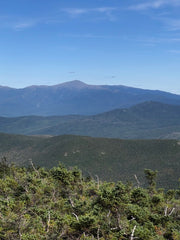One of the best things about hiking in the White Mountains is that amazing views can be found almost anywhere, even on peaks that don’t have the greatest views at the summit. Zeacliff, for instance, offers one of the most incredible viewpoints in the region despite being more than a mile from the fully-wooded summit of nearby Mt. Zealand.
But there is something to be said about spending all day working your way up a long, steep trail and being rewarded with a breathtaking view at the top.
The White Mountains have no shortage of outstanding summits, with the vast majority offering an expansive view of the surrounding landscape in at least one direction with a handful providing a complete 360-degree view. Trying to rank the best summits is an entirely subjective exercise and everybody’s opinions will be different, but there are a handful that most agree are among the very best.
So here, in no particular order, are five summits with views so good you’ll have to see them to believe them.
Mt. Adams
Summit Elevation: 5,799 feet
Recommended Route: Air Line Trail
Mt. Adams may be the second tallest peak in New England, but it's unobstructed view is second to none. While nearby Mt. Washington’s summit boasts large crowds, multiple buildings and significant vehicle traffic at its peak, Mt. Adams has nothing but a summit sign and 360-degree views of the surrounding region waiting for hikers who complete the trek.
Looking south, Mt. Adams’ summit boasts a breathtaking view across the Great Gulf Wilderness to nearby Mt. Jefferson and Mt. Washington. Beyond that lies the entire Pemigewasset Wilderness, with dozens of other White Mountains peaks rising in the distance. To the northeast is Mt. Madison, with Star Lake and the Madison Spring Hut each perched between the two Northern Presidential peaks. The Carter-Moriah range lies to the east, the Pilot Range and New Hampshire’s North Country to the north, and to the west you can see the Green Mountains of Vermont.
Reaching the summit of Mt. Adams isn’t easy. From the Appalachia Trailhead it’s at least 3.8 miles with nearly 4,500 feet of elevation gain using the most direct route, and the terrain above treeline in the Northern Presidential area is notoriously rocky and uneven. That being said, the reward at the top is more than worth the effort.
Bondcliff
Summit Elevation: 4,265 feet
Recommended Route: Zealand Trail, Twinway, Bondcliff Trail
The Bonds are among the most remote peaks in the White Mountains, but anyone who’s made the long trip out will tell you the views are just unbelievable. All three of the Bonds boast views that rank among the best in the White Mountains, and if you were to make a list ranking all 48 peaks by their views, Mt. Bond, West Bond and Bondcliff would all be strong contenders for the top spot.
But in terms of iconic status and sheer grandeur, it’s hard to top the view from Bondcliff.

Home to arguably the most famous viewpoint in the White Mountains, Bondcliff offers a 360-degree view of the surrounding Pemigewassett Wilderness with virtually no sign of human activity in any direction. To the west lies Owl’s Head, the Franconia Range and the Twin Range, to the east is Mt. Carrigain and the Hancocks and to the south is the Sandwich Range and the rest of the southern White Mountains. But the showstopper is the view to the north, where the landslide-scarred bulk of West Bond rises behind the iconic cliff to provide the perfect backdrop for the famous photo. It really is a sight to behold and it makes the 20-mile round trip more than worth the trouble.
There are two common ways to reach Bondcliff. The southern approach is technically easier, with the Lincoln Woods Trail providing a flat but monotonous start before the more difficult climb up the Bondcliff Trail. The northern approach from Zealand is more challenging but has more to offer along the way, including stops at the Zealand Falls Hut, the Zeacliff viewpoint, Mt. Zealand, Mt. Guyot, West Bond and Mt. Bond before finally hitting Bondcliff’s summit. An ideal plan might be to complete a full north to south traverse starting at Zealand and finishing at Lincoln Woods. That way you get all of the great views and then a relatively easy trip out without having to make the difficult climb back up Mt. Bond after summiting Bondcliff.
Mt. Carrigain
Summit Elevation: 4,700 feet
Recommended Route: Signal Ridge Trail
A popular choice for those seeking a big finish to their 4,000-footers journey, the views from Mt. Carrigain’s summit are absolutely epic. Located right in the heart of the White Mountains, few other peaks can match Mt. Carrigain’s sweeping view of the surrounding landscape, and from the peak’s summit tower you’ll have a clear view of nearly every other major mountain in the region.

Mt. Washington and the Presidentials? You can’t miss them. The Pemigewasset Wilderness? It’s all there for you to see. It’s honestly impossible to list every mountain you can see from Mt. Carrigain’s summit, the view really is outstanding and is absolutely one you’ll want to catch on a clear day.
Getting to the summit is usually fairly straightforward. The most popular route is the Signal Ridge Trail, a 5.0-mile approach that is basically flat for the first two miles before steadily climbing for the next three. Shortly before the summit you’ll break out of the trees onto Signal Ridge, which offers you a tantalizing taste of the views before the trail dips back into the trees for the final push to the summit. This climb certainly isn’t easy – and the alternative Desolation Trail is even tougher – but the payoff at the end is absolutely incredible.
Mt. Lafayette
Summit Elevation: 5,260 feet
Recommended Route: Falling Waters Trail, Franconia Ridge Trail, Greenleaf Trail, Old Bridle Path loop
The Franconia Ridge loop is without question one of the most popular hikes in New Hampshire, and it’s easy to see why. The 1.7-mile stretch above treeline between Little Haystack and Mt. Lafayette is just stunning, and if you have clear skies then you could easily go more than an hour with uninterrupted views in every direction as you hike, something that you can’t find many other places in the White Mountains.

Of all the summits along the Franconia Range, Mt. Lafayette stands as the tallest and boasts the best view from its summit. Looking south you can see Mt. Lincoln and the stretch of alpine trail that you’ll have likely just traversed if completing the famous loop. To the east lies Owl’s Head and the Pemigewasset Wilderness thousands of feet below. To the north is Mt. Garfield, with its bald, ledgy summit clearly visible in the distance, and to the west is Franconia Notch, with Cannon Mountain and its sheer cliffs looming across the valley with the Kinsmans not far behind.
If you’re completing the Franconia Ridge loop, you can either start by going up the Falling Waters Trail to Little Haystack and then across to Mt. Lafayette from there, or you can head up the Old Bridle Path to the Greenleaf Hut and then directly to the summit using the Greenleaf Trail from there. If you’re coming on a weekend then plan on arriving early, as the trailhead parking area typically fills up quickly, especially in the summer.
South Twin
Summit Elevation: 4,902 feet
Recommended Route: North Twin Trail, North Twin Spur Trail
Situated near the top of the ring of high peaks that surrounds the Pemigewasset Wilderness, South Twin boasts one of the most underrated views of any 4,000-footer in the White Mountains. In one direction you can see all of the other major peaks in the Pemigewasset Wilderness, with the peaks of Franconia Range, Mt. Garfield, Galehead and Owl’s Head all rising in the distance. Turn around and you’ll see most of the Presidential Range clear as day beyond Crawford Notch, with Mt. Washington looming large over the surrounding landscape.
There aren’t many places in the White Mountains that offer this good a look at both of the region’s most impressive areas at the same time, making South Twin one of the best bang for your buck hikes in all of New Hampshire.

The easiest way to reach South Twin’s summit is from the north. Starting at the North Twin Trailhead, it’s about a 4.1-mile hike to the summit of North Twin, which itself boasts a nice view into the Pemigewasset Wilderness and across to nearby Galehead. The South Twin summit is another 1.1 miles further along, and once there you can either turn back and return the way you came, or if you have a carspot you can also hike down the extremely steep 0.8-mile trail to the Galehead Hut, hit Galehead for your third 4,000-footer of the day and then hike out via the Gale River Trail.
~Mac Cerullo
Link to Read our First Five 4000-Footers Here
Link to Shop our 4000 footer t-shirt here

Burgeon Outdoor was founded in 2019. Burgeon’s mission is to help mountain communities flourish. Burgeon proudly manufactures premium outdoor apparel in Lincoln, NH. By manufacturing locally, Burgeon creates year round jobs in the White Mountains. 5% of Burgeon’s sales support its community and environmental efforts. To learn more, please visit our studio at the Village Shops in Lincoln, our website burgeonoutdoor.com or call us at 603-745-7123.






Comments
Great article, but Garfield once again remains the most underrated 4000 footer
Very nice job with this article. Great suggestions for someone to take and use. Thank You!! Jimmy